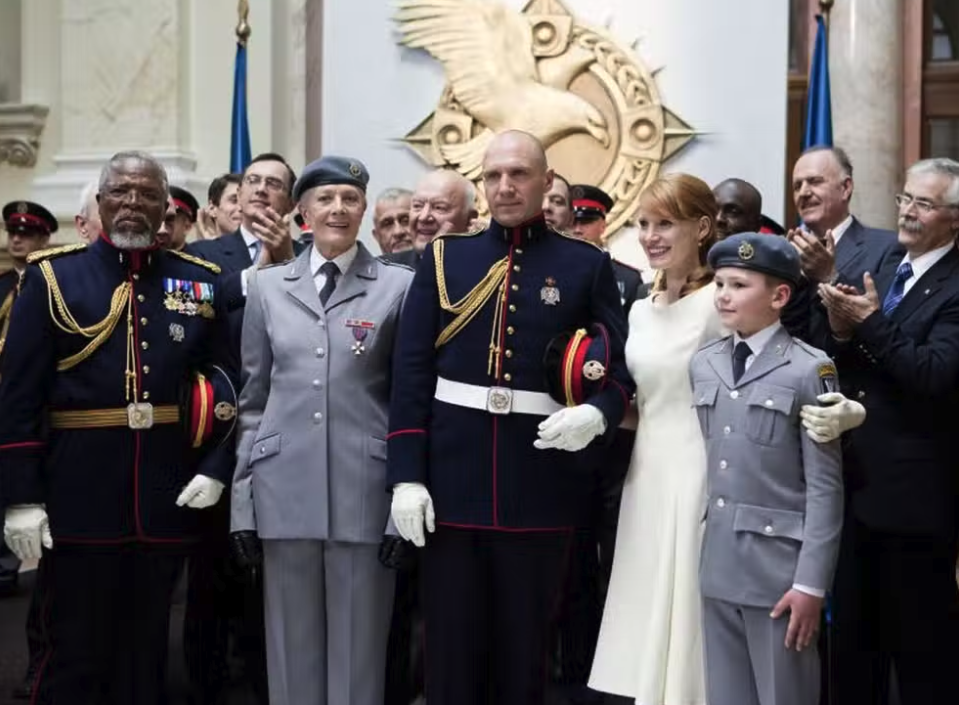The concept of “interface” is often overlooked in the study of performances. The screen interface immerses audiences in an alternate universe in such a way that audiences rarely question the screen’s aesthetic function. That interface often makes itself transparent even though it is generating the dramaturgical meanings central to the narratives. Performance, as a medium, interfaces with textual variants, different scripts, the stage or the film set, and audience expectations. Within some Shakespearean performances, screens are literal and metaphorical interfaces. The interface between humans (story-tellers) and machines (technologies of representation) governs the very logic of screened performance as a narrative medium. Let us take a look at a few examples.
Ralph Fiennes’ 2011 film Coriolanus uses the fictional Fidelis TV channel as an interface to connect three key time zones of (1) the 1990s setting of dramatic action that fuses (2) Elizabethan era ideologies that are (3) mapped onto a Roman history inspired by Thomas Plutarch’s Lives of the Noble Greeks and Romans (1579).
Set “in a place calling itself Rome” in Serbia, a cinematic space created by the newsreels with references to the Yugoslav Wars, this film leans heavily on the screen-within-the-film as a framing device and interface. Protestors are shown filming, on their cell phones, Coriolanus’ (Ralph Fiennes) speech vilifying the plebeians during a conflict at the grain depot.

Jon Snow plays himself as a newscaster who interviews various characters while delivering breaking news in Shakespeare’s blank verse. Multiple scenes show characters, such as Aufidius (Gerard Butler) or Volumnia (Vanessa Redgrave), glued to a television set in tense, pivotal moments.
Appropriately enough, for a film bent on allegorizing the role of public media in modern political life, Coriolanus is banished during a live interview in a television studio. The co-presence of media coverage and on-screen action recasts the film viewers as consumers of the news. The television screen within the film reframes the movie screen in front of the film viewers. The interface of television news goes far beyond their typical function of silent exposition to become the message itself.
Famous lines from Shakespeare can themselves become a gateway to alternate realities. “To be or not to be,” for example, is used as an interface between film viewers and values traditionally associated with “Shakespeare.” John McTiernan’s Last Action Hero (1993) depicts the adventure of Danny Madigan (Austin O’Brien), a schoolboy who is a fan of the action film hero Jack Slater (Arnold Schwarzenegger).
When Danny’s English teacher screens the scene of Hamlet’s soliloquy from Laurence Olivier’s film, a bored Danny envisions the scene as it should be played, starring a Terminator-esque Slater in Olivier’s costumes, who smashes his way through stalled moments in Hamlet without hesitation. Watch the Hamlet scene in Last Action Hero here.
Recast in the role of Hamlet, Slater asks himself, “to be or not to be?” Lighting up the cigar in his mouth, he declares “not to be” as he ignites explosives without hesitation, killing all the characters in Hamlet. The scene is an example of how films interface other modes of presentation. Olivier’s psychological realism and clichéd theatrical style of performance on screen are overwritten by the school boy’s imagination that draws on more contemporary cultural reference points. James Cameron’s Terminator 2: Judgment Day made Schwarzenggar a bankable global star in 1991, two years before the release of Last Action Hero.
These uses of screens-within-the-film or Shakespearean artifacts as an interface anticipate the Wooster Group’s meta-media and multi-media stage production of Hamlet (dir. Elizabeth LeCompte, 2007) in which the actors projected onstage a filmed version of Richard Burton’s performance in a 1964 Hamlet (dir. John Gielgud) on the Broadway. Burton’s onscreen Hamlet ghosts Scott Shepherd’s onstage Hamlet.
In addition to the 1964 Hamlet, which is playing on a big screen upstage as pre-recorded material, another smaller screen is present downstage. The smaller screen, standing behind the actors but in front of the large screen, shows a live video stream of their action primarily in the form of closeup shots of their faces. Actors speak the same lines synchronously with Burton’s performance. On some occasions, the soundtrack from Burton’s video contributed to uncanny dual soundtracks of live and pre-recorded speeches. On other occasions, the actors appeared to be ventriloquizing, or mouthing, lines from Burton’s video, because the louder soundtrack of the project drowned out the stage action.
Three observations can be made about these instances of interfacing Shakespeare onscreen. First, the screen as interface has created deep structural connections among even works that seem to be isolated instances of artistic creation. The connections extend through the cultural practice of interfacing different media, such as film, theatre, visual arts. The cases above relate more frequently to one another, through the screening interface, than to Shakespeare as sanctified source material.
Secondly, these works are products of meta-cinematic and meta-theatrical operations and contestations among genres for primacy. The meanings of these narratives are shaped by the interface between disparate genres.
Thirdly, this interface culture has given rise to digitally enhanced global Shakespeare performances. While in the 1990s audiences typically encountered Shakespeare for the first time through film or theatre, in our times the initial encounters occur predominantly on digital platforms in the form of video clips, memes or quotes. It has become more common for non-professional readers and audiences to encounter Shakespeares in fragmented forms. “To be or not to be,” even in fragmented forms and out-of-context quotations, carries weight and shifts the meanings of some characters’ action.
It is now commonplace to integrate Shakespeare in traditional film format on the big screen into personalized experiences on the small screen for personal entertainment or for education. The interface of the screen is now a portal through which audiences experience Shakespeare’s narratives with a range of associated artistic elements including costumes, sets, and music.
===================
This is an excerpt from Alexa Alice Joubin’s “Interfacing Shakespeare Onscreen” in The Routledge Handbook of Shakespeare and Interface (2023), ed. Clifford Werier and Paul Budra, pp. 332-344 [PDF]
Abstract
The screen as an interface immerses audiences in an alternate universe. As a result, that interface seems transparent. Through analyses of performances that call attention to filmic genres, such as Edgar Wright’s parody film, Hot Fuzz (2007), and the Wooster Group’s multimedia production, Hamlet (2007), as well as (meta)theatrical operations on small screens within cinematic and digital performances, such as Ralph Fiennes’ Coriolanus (2011), the Royal Shakespeare Company’s Dream (2021), and Michael Almereyda’s film Hamlet (2000), this chapter argues that the screen is an interface that generates dramatic meanings and that promotes audiences’ self-reflexivity.
Performance, as a medium, interfaces with textual variants, audience expectations, and site-specific arts—artworks produced and consumed at specific physical sites and in designated social spaces. Performances with screens as interface, in particular, create celluloid and digital pathways to various ideologies. The interface between humans (story-tellers) and machines (technologies of representation) governs the very logic of screened performance as a narrative medium.
With case studies showing how screens big and small have become more than technologies of representation, this chapter reveals the central place of screen as interface between the different universes of the characters, the performers, and the audiences.
Read the full text here.





